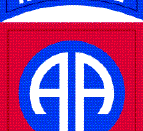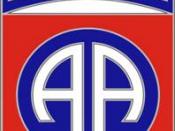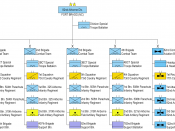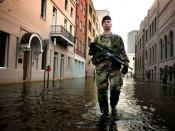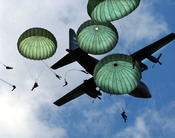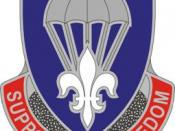I hated being late. Especially when the Commanding General of the 82nd Airborne Division was watching me. It was decision time. I had to get my aircraft closed up and moving. My crew was flying the lead aircraft of a nine-ship night paratrooper drop. If we did not get off the ground soon somebody was going to be in trouble, and that someone was probably going to be me.
Well, I decided to make some command decisions and the mission continued. We were able to launch on time. As I mopped the sweat from my eyes, Major General Vines, commanding officer of the 82nd, approached me. He reached out and handed me a coin. He said the coin was for doing whatever it took to get the job done. I looked down at the golden medallion. It had the flag of the commander on one side. The other was embossed with the emblem worn on the shoulder of every soldier in the 82nd.
The distinctive "AA"ÃÂ was indicative of the unit's airborne legacy. Below the symbol were the names of every drop-zone the 82nd had assaulted in combat. The one drop that caught my eye was Normandy. On the night of June 5, 1944, American forces parachuted into the fields of France. Their assault was the opening move in the battle to free Europe from Hitler. That coin brought everything into perspective for me. What I was doing that night was not a game. We were not training for fun. American paratroopers had been dropped into actual combat that night in 1944. The men that looked at me though the dim red light of the airplane were no different than the troopers who jumped into Normandy. Those soldiers, like today's airborne, were young and scared volunteers who knew what dedication to a cause meant. These were men who were willing to sacrifice all for a belief in their country and their unit. Without the men of the 82nd Airborne Division, Allied victory in Normandy might have come at a much higher cost.
The idea of delivering troops from the sky dates back almost six centuries. Leonardo Da Vinci was the first person to document how a man could descend to earth from a parachute. Later, with the invention of the airplane, military leaders began to see the strategic use of the parachute. General Billy Mitchell actually drew up plans for an airborne assault in the First World War; however, the war ended before that plan was executed. The first airborne soldiers would not go into battle until World War II (Crookenden 13).
The United States was not the first country to utilize airborne units in WW II, but it did not take U.S. military leaders long to see the possibilities for aerial delivery of combat troops. The U.S. took notice of the German parachute infantry in the early stages of the war (Hooker 1). On June 25, 1940, a Parachute Test Platoon was set up at Ft. Benning, Georgia. The unit was made up of volunteers from other military units (Crookenden 14). Later that year the platoon was expanded to form an actual infantry battalion. The 501st Parachute Infantry Battalion was the first unit of its kind in the United States Army (Crookenden 14).
The goal of the 501st was to train jumpers and form airborne doctrine (Crookenden 18). These men had to design all of their equipment on their own. There were no examples to copy (Crookenden 18). The all-new airborne units were streamlined combat formations. Comprised of an all-volunteer force, they were highly trained and motivated. The new formations traveled light, and the airborne division was to be made up of only 8,300 officers and men (Devlin 128). The pioneering officers and non-commissioned officers of the 501st were subsequently used to create other airborne battalions. In mid 1941, several units were able to stand up as complete airborne infantry battalions. These units merged together, and on August 15, 1941, the 82nd Airborne Division was formed at Ft. Bragg, North Carolina (Crookenden 20).
It was not long before the newly formed 82nd Airborne Division, also known as "Division"ÃÂ by assigned soldiers, was sent overseas. The Division headed to North Africa in late 1943 (Crookenden 25). Small-scale drops were first tried in North Africa and then in Sicily (Hooker 1). Many of the plans created back in the U.S. were put to the test. It was immediately seen that there would have to be some changes made to the new doctrine (Crookenden 25). In the Sicily operation, much of the 82nd was scattered far from intended drop zones due to poor navigation. During subsequent drops on Sicily, Allied forces fired upon the aerial reinforcements. General Gavin, then commander of the 82nd, set about to improve the success of his unit (Crookenden 25). Gavin was a young leader who had risen quickly in the newly formed division. The 82nd needed a commander like Gavin, because Allied leaders had big plans for airborne units.
The big plan Allied leaders had in mind was the invasion of Northern Europe. The attack was to be known as Operation Overlord. The date selected was June 6, 1944. That date was referred to as D-Day. The D-Day invasion was to be the final push of the Allied forces to free Europe of Hitler. Allied airborne units, both American and British, would have a leading role in Overlord. They were to enter France on the night of June 5th undetected and disrupt German reinforcements trying to reach the amphibious assault occurring on the nearby Normandy beaches (Devlin 356). The success of airborne units was critical.
The 82nd was dropped into fields not far from the French town of Ste. Mere-Eglise on the nights of June 5 and 6, 1944. Ste. Mere-Eglise was located on strategic high ground only five miles from the ocean (McCaul 1). Units were then supposed to seize key bridges located along the Merderet River. Protection of the amphibious landings was paramount. The Allied amphibious advance was supposed to quickly link up with the airborne units and press the attack inland (McCaul 1). General Eisenhower, the commander of Overlord, feared that without the protection provided by the airborne, the Germans would throw the invasion force off the beaches (Devlin 130). Each aspect of the operation was critical, but it would all come down to the men required to execute it.
In war most plans do not survive after the first few shots are fired. It took volunteers like Sergeant Bill Dunfee to make the drop into Normandy a success. Ed McCaul chronicled his account in the journal titled Military History. Mr. Dunfee was an early member of the 82nd, and was one of only a few members of the 82nd who participated in all of Divisions WWII combat jumps (McCaul 2). Dunfee fought with distinction until his part of the 82nd was relieved 32 days after the initial D-Day assault (McCaul 7). When asked what combat was like in the Normandy countryside Dunfee said, "It was terrible! There was only about 100 yards between the hedgerows. The Germans would let us get out in the middle of a field and then open up. When they did, we were dead meat."ÃÂ (McCaul 7). Danger or not the men of the 82nd had seized all of their objectives by the 7th of June. The D-Day landings were successful.
With the completion of operations in Normandy, the 82nd Airborne Division seized its place in the history books. The Division continued to fight with distinction until the fall of Hitler in April of 1945 (McCaul 8). Sergeant Dunfee and his comrades were finally able to go home to their loved ones. The 82nd lived on and fought with valiantly in several other conflicts, including Vietnam, Grenada, Panama, and Operation Desert Storm. The Division continued to train and fight with the original ideals instilled by the volunteers in the Airborne Test Platoon. Those experiences after WWII helped define what the shape of the future 82nd would be.
The United States will have an airborne force in the twenty-first century. The plan for the 2010 version of the 82nd is already being conceived (Hooker 2). The new Division will continue to be light, but will become even more versatile. Since the airborne force will usually fight at a numerical disadvantage, they will be provided with the most high tech firepower available. Division will be equipped with new light tanks, and extremely agile and lethal helicopters (Hooker 3). These new technologies will combine with the tenacious airborne spirit to create a dangerous combination for future enemies to deal with.
Sometimes I lose sight of what is right in front of me. It is funny how just one object can bring things into perspective. There was nothing unique about the decisions I made on the night I received my coin. I just needed to drive on and do my part. Americans doing their part is what freed WW II Europe from terror. I am not a member of the 82nd, but I am proud to say that if I am ever called upon I will help them write their next victorious chapter in the pages of history.
Works Cited Crookenden, Napier. Dropzone Normandy. New York: Charles Scribner's Sons, 1976 Devlin, Gerard. PARATROOPER. New York: St. Martin's Press, 1979.
Hooker Jr., Richard. "The Airborne Division in 2010."ÃÂ Military Review. 81.3 (May/June 2001): 83.
McCaul, Ed. "82nd airborne paratrooper at Normandy."ÃÂ Military History. 14.2 (June 1997): 30.
